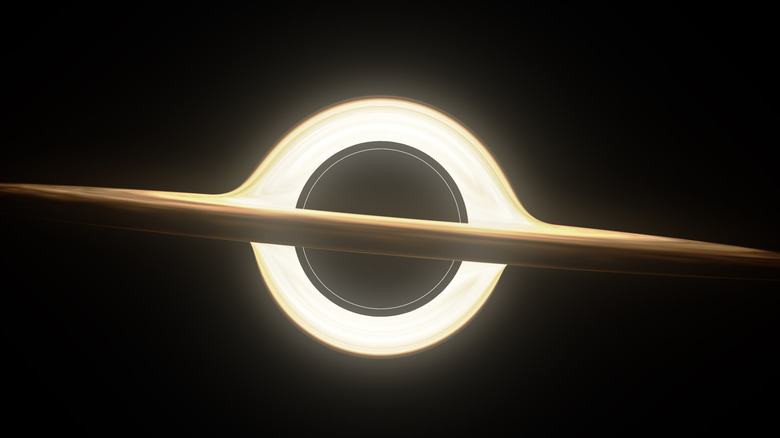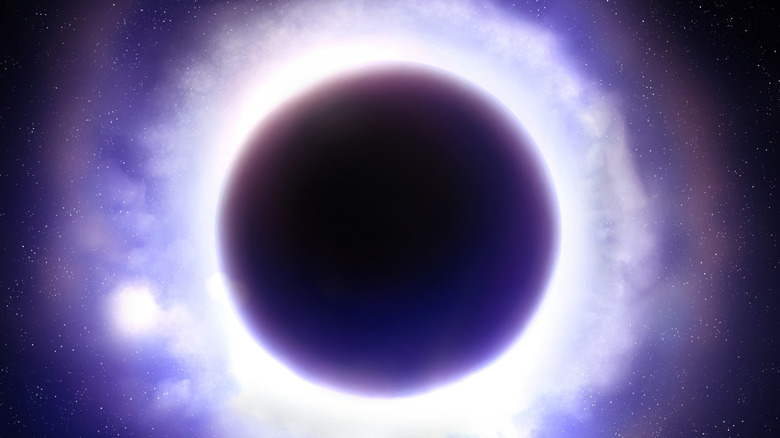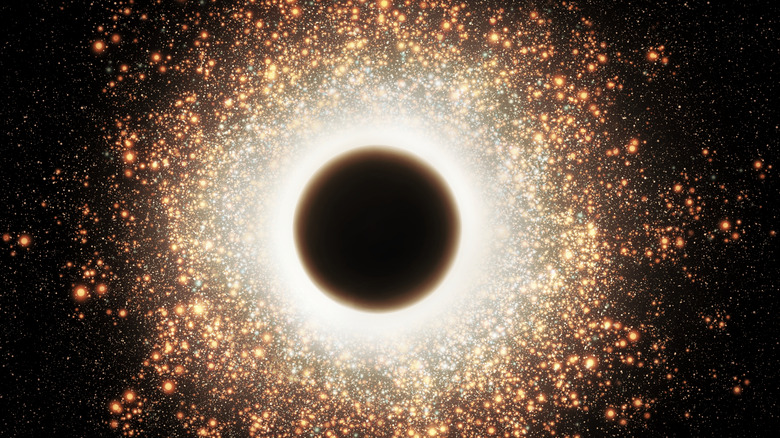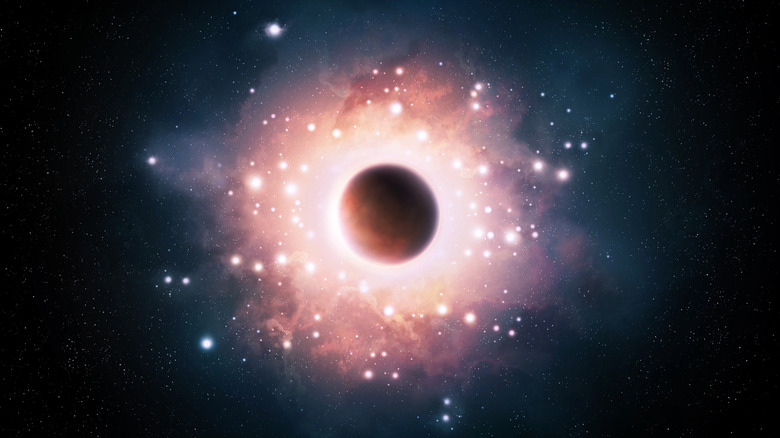Here's What Happened When Physicists Simulated A Black Hole In A Lab
While scientists are getting ever closer to understanding the nature of black holes, that doesn't make these fascinating cosmological objects any less mysterious. Black holes are concentrations of matter so dense that not even light can escape. This area of tightly packed matter, known as the singularity, is surrounded by a boundary called the event horizon — the surface of the black hole and the point beyond which the velocity required to escape exceeds the speed of light. Since nothing is faster than light, nothing can escape a black hole once it falls inside the event horizon.
Unfortunately (or fortunately depending on how you look at it) we're not able to get close enough to really study a black hole. The nearest known example, Gaia BH1, is around 1,500 light-years from Earth, and it was only in 2019 that astronomers captured the first-ever blurry image of a black hole — an object that looked alarmingly similar to the Eye of Sauron from "The Lord of the Rings."
But as it turns out, we don't necessarily need to travel 1,500 light years to get close to such a foreboding cosmological phenomenon. At least, we don't need to travel so far to experience an event horizon. In 2022, physicists managed to simulate a black hole in the lab and, as you might expect, things got weird very quickly.
Creating an event horizon on earth
In November 2022, a team of physicists from the University of Amsterdam in the Netherlands created a version of an event horizon in the lab. They laid out their findings in a paper entitled "Thermalization by a synthetic horizon," published in Physical Review Research. As you might imagine, creating a black hole in a lab is more than a little complex, but put simply, the researchers managed to simulate the event horizon of a black hole by using a chain of atoms.
Led by PhD researcher Lotte Mertens, the group arranged a single-file chain of atoms that they manipulated to simulate the event horizon of a black hole. Specifically, the researchers tuned the ease with which electrons could hop from atom to atom, thereby creating a synthetic event horizon. After this, the team manipulated the chain of atoms so that a piece of it went over the event horizon they had created and noted a spike in temperature as a result. Perhaps more significant was the fact that the researchers saw their simulated event horizon start to glow, which provides further evidence of a phenomenon known as Hawking radiation.
Hawking radiation and the event horizon
In 1974, physicist Stephen Hawking put forward a theoretical concept that became known as "Hawking radiation." In simple terms, it refers to particles being created at the event horizon of a black hole. These particles are thought to be caused by the immense gravitational pull of black holes warping spacetime and causing disturbances in something called the quantum field.
The quantum field is a term that actually refers to multiple fields that are omnipresent throughout the universe. The concept proposes that, at the smallest scale, our universe is made up of different fields — just like the magnetic field — so that even when there appears to be nothing present in spacetime, there is in fact a vast field of matter and energy in the form of various quantum fields. When disturbances or excitations in these fields occur and ripples form, what we refer to as particles are created. In other words, a particle is just a ripple in a certain field. But even without major disturbances, quantum fields are constantly producing what are known as "virtual particles" — particle and antiparticle pairs that are popping in and out of existence all the time.
Hawking focused on the idea of this process unfolding right on the cusp of a black hole's event horizon. The physicist theorized that if, after a pair of virtual particles are produced at the edge of the horizon, one could cross the event horizon and become trapped in the black hole, while its counterpart would remain in existence outside the event horizon. This leftover particle is what is known as Hawking radiation" and is key to the findings in the Amsterdam experiment.
Why Hawking radiation is so important
Since humankind has never actually observed a black hole or its event horizon close-up, Hawking radiation has never been witnessed. Even if we could get close enough to a black hole to observe the event horizon, the amount of the photons Hawking predicted is thought to be tiny, meaning they would likely be unobservable to the human eye and certainly wouldn't cause a strong enough reaction for our telescopes to detect.
This is why the Amsterdam experiment is so intriguing. The creation of Hawking radiation particles is thought to result in a faint glow of radiation similar to thermal radiation — a glow like the one witnessed by the researchers. Essentially, then, while this wasn't the first time a black hole analogue was created in a lab, the experiment was the first time researchers were able to tune an event horizon analogue to produce radiation, thereby adding more evidence in favor of Stephen Hawking's theory.
Physicists are keen to explore Hawking radiation as it has implications for the two major theories that explain how nature functions. One is the general theory of relativity — one of Albert Einstein's major breakthroughs — which describes the force of gravity and the natural world at a macro level. The other is quantum mechanics, which describes the behavior of particles at a subatomic level and covers the forces of electromagnetism and the two nuclear forces. The two theories have remained incompatible since their inception, prompting scientists to search for a single unified theory, otherwise known as a theory of everything, to explain how reality works. Hawking radiation combines elements of both theories and is therefore an extremely exciting concept that could hold answers to some of the biggest issues facing physicists. This latest experiment is another step towards bridging the gap between the two theories.



